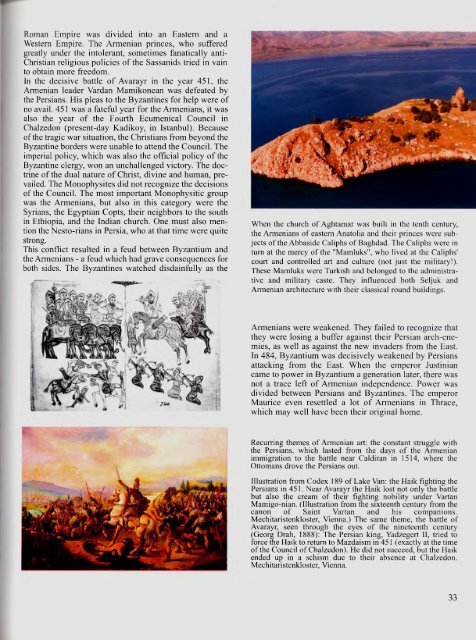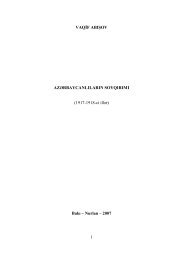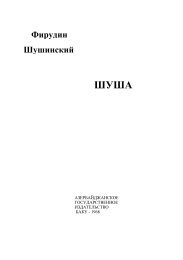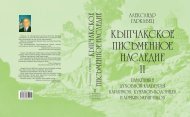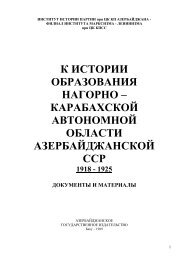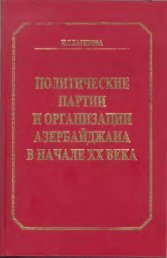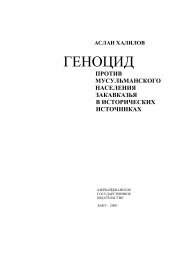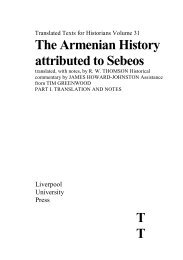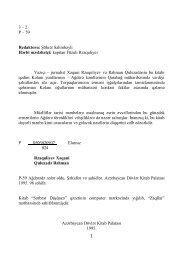ARMENIAN - Erevangala500
ARMENIAN - Erevangala500
ARMENIAN - Erevangala500
You also want an ePaper? Increase the reach of your titles
YUMPU automatically turns print PDFs into web optimized ePapers that Google loves.
Roman Empire was divided into an Eastern and a<br />
Western Empire. The Armenian princes, who suffered<br />
greatly under the intolerant, sometimes fanatically anti-<br />
Christian religious policies of the Sassanids tried in vain<br />
to obtain more freedom.<br />
In the decisive battle o f Avarayr in the year 451, the<br />
Armenian leader Vardan Mamikonean was defeated by<br />
the Persians. His pleas to the Byzantines for help were of<br />
no avail. 451 was a fateful year for the Armenians, it was<br />
also the year of the Fourth Ecumenical Council in<br />
Chalzedon (present-day Kadikoy, in Istanbul). Because<br />
of the tragic war situation, the Christians from beyond the<br />
Byzantine borders were unable to attend the Council. The<br />
imperial policy, which was also the official policy of the<br />
Byzantine clergy, won an unchallenged victory. The doctrine<br />
of the dual nature of Christ, divine and human, prevailed.<br />
The Monophysites did not recognize the decisions<br />
of the Council. The most important Monophysitic group<br />
was the Armenians, but also in this category were the<br />
Syrians, the Egyptian Copts, their neighbors to the south<br />
in Ethiopia, and the Indian church. One must also mention<br />
the Nesto-rians in Persia, who at that time were quite<br />
strong.<br />
This conflict resulted in a feud between Byzantium and<br />
the Armenians - a feud which had grave consequences for<br />
both sides. The Byzantines watched disdainfully as the<br />
When the church of Aghtamar was built in the tenth century,<br />
the Armenians o f eastern Anatolia and their princes were subjects<br />
of the Abbaside Caliphs o f Baghdad. The Caliphs were in<br />
turn at the mercy o f the "Mamluks", who lived at the Caliphs'<br />
court and controlled art and culture (not just the military!).<br />
These Mamluks were Turkish and belonged to the administrative<br />
and military caste. They influenced both Seljuk and<br />
Armenian architecture with their classical round buildings.<br />
Armenians were weakened. They failed to recognize that<br />
they were losing a buffer against their Persian arch-ene-<br />
mies, as well as against the new invaders from the East.<br />
In 484, Byzantium was decisively weakened by Persians<br />
attacking from the East. When the emperor Justinian<br />
came to power in Byzantium a generation later, there was<br />
not a trace left o f Armenian independence. Power was<br />
divided between Persians and Byzantines. The emperor<br />
Maurice even resettled a lot o f Armenians in Thrace,<br />
which may well have been their original home.<br />
Recurring themes o f Armenian art: the constant struggle with<br />
the Persians, which lasted from the days o f the Armenian<br />
immigration to the battle near Caldiran in 1514, where the<br />
Ottomans drove the Persians out.<br />
Illustration from Codex 189 of Lake Van: the Haik fighting the<br />
Persians in 451. Near Avarayr the Haik lost not only the battle<br />
but also the cream o f their fighting nobility under Vartan<br />
Mamigo-nian. (Illustration from the sixteenth century from the<br />
canon o f Saint Vartan and his companions.<br />
Mechitaristenkloster, Vienna.) The same theme, the battle of<br />
Avarayr, seen through the eyes o f the nineteenth century<br />
(Georg Drah, 1888): The Persian king, Yadzegert II, tried to<br />
force the Haik to return to Mazdaism in 451 (exactly at the time<br />
o f the Council o f Chalzedon). He did not succeed, but the Haik<br />
ended up in a schism due to their absence at Chalzedon.<br />
Mechitaristenkloster, Vienna.<br />
33


